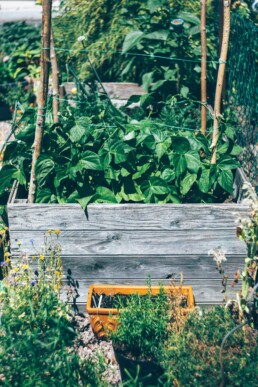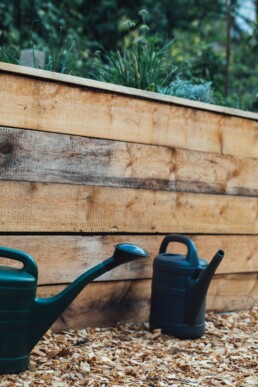Gardening is en vogue. More and more people are getting back to nature, working in their own garden, paying attention to natural gardening, where you can forget your everyday life and relax. This includes using your own garden - no matter how big or small - to grow vegetables, fruits and herbs.
Fortunately, environmental awareness continues to increase and so it is becoming more and more important for people to pay attention to seasonal and local products. The way of fruit, vegetables etc. to our supermarkets is often long, the CO2-print thereby large. If you grow your own, you also know where the food comes from. That, too, is crucial for many people.
The raised bed has therefore been increasingly popular for years. Made of stone, wood, self-assembled, ready-made kits, one, two or even five pieces, in the garden, in the greenhouse or on the balcony - everything is possible. In the following, we would like to introduce you to how you can create a raised bed and what needs to be considered. And of course, our smart to plan measurement app can be helpful here again. How? We'll tell you!
The design of the raised bed
When it comes to designing a raised bed, there are no limits to your imagination. You can use kits, which are usually easier to assemble, but are also often more expensive. You can also build the raised bed yourself from natural leftover boards, plaited willow branches, stones or even sheet metal. You can also determine the shape and height yourself, although you should make sure that you can garden comfortably and back-friendly. The raised bed should also ideally be located in the southwest in order to make optimal use of the long sunlight there. Depending on the hours of sunshine, the choice of vegetables and herbs is different. In addition, the bed should not be too exposed to wind.
Protect the raised bed from intruders
A huge advantage of the raised bed is that you plant your vegetables and herbs protected from pests. If you grow vegetables on the ground, you will always have to struggle with moles, voles and snails. To avoid this, you should cover the floor with close-meshed wire mesh that is pulled up about 10cm on the sides. Wooden frames in particular should be lined with thick fabric film or a dimpled sheet and fastened with nails / roofing nails so that it does not rot so quickly. In addition, the surface should be level so that the water runs off evenly.


The filling of the raised bed
It is practical that the raised bed can be used as a kind of composter and the entire volume does not have to be filled with high-quality soil, which would quickly become very expensive. In addition, the soil organisms in the soil layers that are deeper than 40-50cm do not have enough oxygen available so that they would not survive there. You can stick to the simple rule when filling: The filling material becomes finer and finer towards the top. If you want to plant vegetables, the following filling is recommended for a total height of 80 cm (from bottom to top):
- Coarse tree and shrub cuttings such as branches and twigs can make up about the first 20 cm
- On top of it again about 15-20 cm of shredded material (non-rotted compost, thin branches, wood, leaves, lawn clippings)
- If available, you can put the turf that was removed for the raised bed on top - inverted
- This is followed by 15 cm of coarse compost
- and 15 cm of mature compost
- You can then fill the remaining space up to the top with high-quality garden soil or mix it directly with the mature compost
The lower layers in particular should be compacted well, as the rotting process will lower the content. After about a year, you can expect to top up another 10cm with garden soil or garden soil-compost mixture.
The raised bed and the seasons
In principle, you can create the raised bed in autumn, but May is not too late either. In March and April it was the turn of the harbingers of spring such as radishes, rocket, spinach, onions and leeks. In May, young plants of cucumbers, courgettes, peppers and, for example, chilli will follow. Even the pumpkin can soon move into the raised bed - preferably on the edge to tend over the raised bed. If the kohlrabi, carrots and tomatoes are not yet in the bed, now is high time. The same applies to herbs, which can, however, also be planted around the garden.
Mixed culture in the garden bed
Organic crop protection should be relied on, especially when it comes to home-grown vegetables. Certain combinations of plants scare off certain animals or reduce the risk of disease. Therefore, a mixed culture is also an option in your own raised bed. Here are a few tips:
- Chervil repels ants, slugs, aphids and mildew
- Spinach, planted next to lettuce, repels ground fleas
- Parsley, planted next to strawberry, helps against slugs
- Basil next to cucumber and zucchini provide protection from mildew
- Garlic has a bactericidal as well as fungicidal effect in relation to strawberry plants
- And probably one of the most popular combinations are carrots and onion plants. Onion plants drive away the carrot flies and the carrots drive away the onion flies
The greatest advantages at a glance
The advantages of raised beds are numerous. Having your own vegetables in the garden is undoubtedly the best thing that the raised bed offers, but other advantages should not go unmentioned.
Raised beds allow ergonomic weeding and are great for the back. The height of the bed can be selected by the user depending on his or her height, which avoids bending.
Also, vegetables etc. are protected from pests, which makes the harvest more productive.
No matter how fertile the soil in the garden - planting vegetables will certainly work in the raised bed, because the soil texture itself can be optimized.
And what does smart to plan have to do with the raised bed?
With smart to plan you can easily measure the area for a raised bed. This mainly helps to cut wood and determine the volume for the garden soil and the dimensions of the foil and wire. To do this, all you need is our measurement app, start a measurement and measure the area where you want to create the raised bed. You don't need a folding rule or paper, you can find all the information you need on your smartphone. You can even show this to the hardware store so they can cut wood and you buy the correct amount of soil - it can be that easy!
Have fun creating your raised bed!
uncode-placeholder



